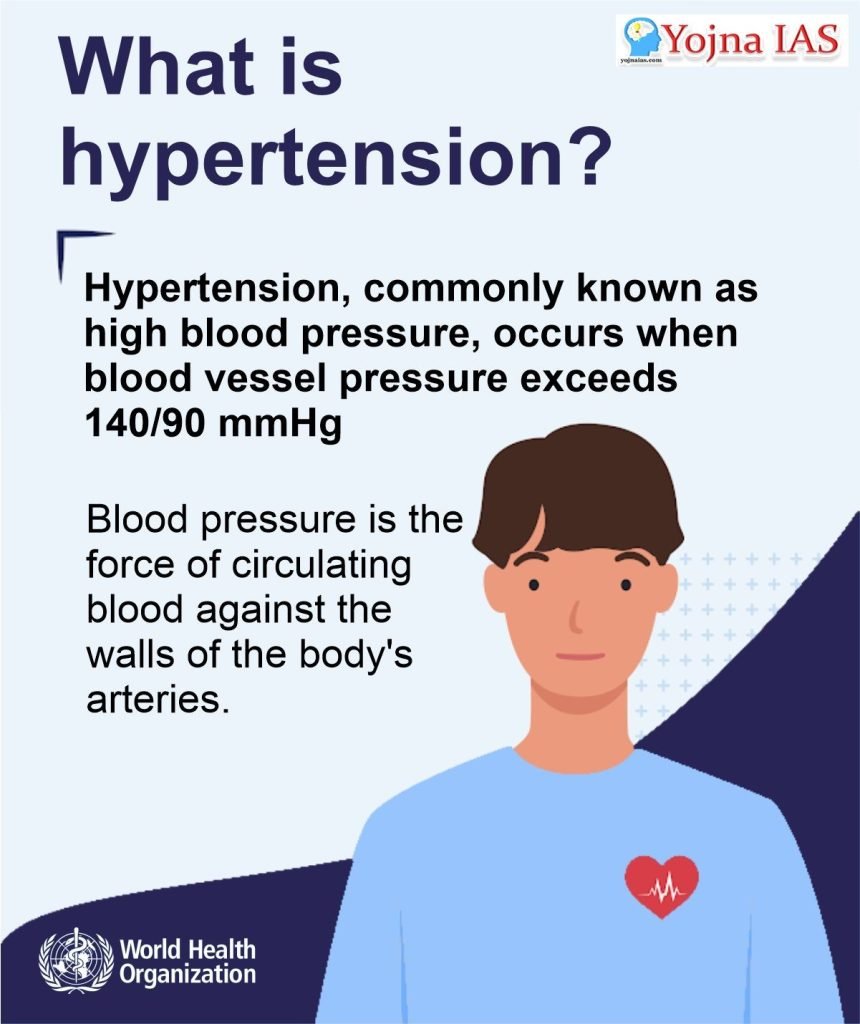22 Sep 2023 WHO Releases Global Report on Hypertension
This article covers “Daily Current Affairs” and the topic details “WHO Releases Global Report on Hypertension”. This topic has relevance in the “Social Justice” section of the UPSC CSE exam.
For Prelims:
What is Hypertension?
Who releases the Global Report on Hypertension?
For Mains:
GS2: Social Justice
Why in the news?
World Health Organization (WHO) released its first-ever report on the global impact of high blood pressure on 19 September.
Global Report on Hypertension: The Race Against a Silent Killer
- The World Health Organization (WHO) has unveiled its latest report titled “Global Report on Hypertension: The Race Against a Silent Killer.”
- This report marks the first comprehensive compilation of data on the extensive consequences of uncontrolled hypertension, encompassing heart attacks, strokes, premature death, and substantial economic burdens on communities and nations.
Understanding Hypertension
- Hypertension, commonly known as high blood pressure, occurs when blood vessel pressure exceeds 140/90 mmHg. While prevalent, untreated hypertension can have serious health implications.

Key Findings from the Report
- Global Impact:
-
- High blood pressure now surpasses other leading risk factors, including tobacco use and high blood sugar, as a cause of mortality worldwide.
- The report reveals a twofold increase in the global population affected by hypertension between 1990 and 2019, with over three-quarters of affected adults residing in Low- and Middle-Income Countries (LMICs).
- High systolic blood pressure ranks as the leading global risk factor for mortality.
- Indian Perspective:
-
- India records an estimated 188.3 million adults aged 30–79 with hypertension.
- To attain a 50% control rate, an additional 67 million individuals in India require adequate treatment.
- The nation’s hypertension prevalence, at 31%, slightly lags behind the global average. Approximately 37% have received diagnoses, while 30% are undergoing treatment.
- The India Hypertension Control Initiative, a part of the National Health Mission, has garnered recognition for its commendable work in primary healthcare.
- The Silent Killer:
-
- Hypertension affects one in three adults and often manifests without symptoms, earning its reputation as the “silent killer.”
- Nearly half of those with hypertension are unaware of their condition.
- Global Prevalence:
-
- One-third of the world’s adult population faces hypertension, predisposing them to heart disease, stroke, and mortality.
- Males exhibit a slightly higher prevalence (34%) than females (32%).
- Hypertension Care:
-
- Among adults aged 30–79 with hypertension, only 54% have received diagnoses, 42% are undergoing treatment, and 21% have their hypertension under control.
- Treatment coverage ranges from a high of 60% in the Region of the Americas to a low of 27% in the African Region.
- Global Targets and Prevention:
-
- The world is not on track to meet the voluntary global target of a 25% reduction in raised blood pressure prevalence by 2025.
- Increasing global hypertension control to 50% could prevent 76 million deaths between 2023 and 2050, aligning with the Sustainable Development Goal target 3.4 of reducing premature mortality from non-communicable diseases.
- Key Recommendations
-
- National Leadership and Accountability: Establish national mechanisms to oversee and enhance the allocation of resources and implementation of integrated responses to noncommunicable diseases, specifically focusing on hypertension control.
- Comprehensive Programs: Develop programs addressing hypertension risk factors, including promoting healthy diets, reducing tobacco and alcohol use, and integrating physical activity into daily life.
- Implement WHO HEARTS Package: Adopt drug-specific treatment protocols, ensure a reliable drug supply, create team-based care, make healthcare patient-friendly, and establish an accurate information system for hypertension care data.
- Address Broader Factors: Strengthen healthcare systems and expand hypertension services to reach everyone gradually.
Download Yojna daily current affairs eng med 22nd Sep 2023
Q1. With reference to the Global Report on Hypertension, consider the following statements:
- The first report on Hypertension was published in 2020.
- The Global Report on Hypertension was published by the World Health Organization (WHO).
- The report is a comprehensive compilation of data on the wide-ranging impacts of uncontrolled hypertension, including heart attacks and strokes.
Which of the statements given above is/are correct?
(a) 1 and 2 only
(b) 2 and 3 only
(c) 3 only
(d) None
Answer: (b)
Q2. Consider the following:
- According to the Global Report on Hypertension, nearly two-thirds of those with hypertension are unaware of their condition.
- The India Hypertension Control Initiative is a part of the Ayushman Bharat.
- One-third of the world’s adult population faces hypertension, with females being more prevalent than males.
How many of the abovementioned statements are correct?
(a) Only one
(b) Only two
(c) All three
(d) None
Answer: (d)
Q3. Examine the WHO’s ‘Global Report on Hypertension,’ its significance for global public health, and challenges in tackling hypertension.


No Comments